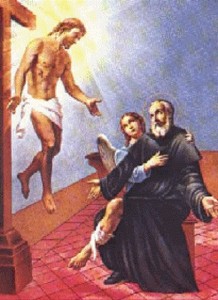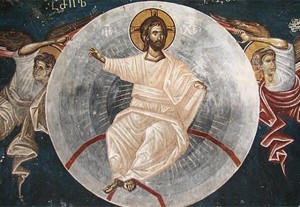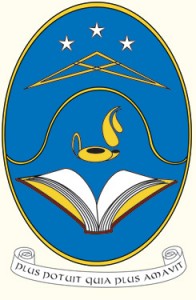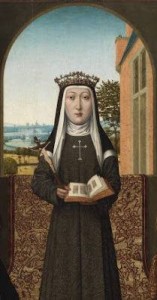 Saint Mary of the Incarnation was Widow, Ursuline nun (1599-1672). She was canonized on 2 April 2014 by Pope Francis. Born in Francis was purified in Canada and made a saint God for our redemption. Crucially, she reminds us of the question to whom do we belong. Hopefully we can say “we belong to Christ Jesus.”
Saint Mary of the Incarnation was Widow, Ursuline nun (1599-1672). She was canonized on 2 April 2014 by Pope Francis. Born in Francis was purified in Canada and made a saint God for our redemption. Crucially, she reminds us of the question to whom do we belong. Hopefully we can say “we belong to Christ Jesus.”
Marie Guyart Martin, fourth child in a family of seven children, was born in Tours, France. When very young, she had a dream that moved her profoundly. I was about seven years old, she wrote. In my sleep one night, it seemed to me that I was in a schoolyard… Suddenly the skies opened, and Our Lord emerged, advancing toward me! When Jesus neared me, I stretched out my arms to embrace Him. Jesus embraced me affectionately and asked me: Do you want to belong to Me?’ I answered, Yes.’ She was unceasingly to repeat that yes, the key to her entire life, amid joys and afflictions.
When Mary was eighteen, her parents believed she was ready to get married. She obeyed and married Claude Martin, a master silk worker. In 1619 she gave birth to a son, who was one day to become Dom Claude Martin. Six months later, the Lord marked her with the seal of His predilection: she was visited by the cross of widowhood, with all its trials. Mary of the Incarnation felt strongly attracted to the religious life, be she realized that God’s hour had not yet struck.
Several very difficult years ensued. Having found employment in her sister’s house, she became the slave of the servants of the household. In this harsh situation, our Saint practiced the virtues of humility, charity, patience and total self-forgetfulness to the point of heroism. She remained constantly in the holy presence of God, even amid the most absorbing occupations.
At the age of twenty-one, though still in the lay state, she made the vows of poverty, chastity and obedience. In 1625, God gratified her with a vision of the Holy Trinity.
When Madame Martin was thirty-one, the call of God to leave everything echoed imperiously in her soul. On January 25, 1631, she bid farewell to her elderly father, and overcoming the pangs of her maternal heart, she entrusted her eleven-year-old son to her sister’s care. This absolute detachment, which makes her a model for parents, was one of the most heroic and sublime acts in the life of Saint Mary of the Incarnation. The courageous mother told her child, God wills it, my son. If we love Him, we should will it, too. It is up to Him to command, and up to us to obey. With a broken heart, she was finally able to enter the Ursuline Novitiate in Tours.
Eight years later, when she had reached the age of forty, Mary of the Incarnation embarked at Dieppe with some companions on a ship headed for Canada. She is among the very first nuns to have come to America. At the time, such a missionary adventure was regarded as an innovation. There was no room for anything less than heroism for these pioneers of the Church of New France, who united the cloistered life to the missionary life. Mary of the Incarnation wrote, Here we encounter a kind of necessity to become saints. We must either die or fully consent to it.
She studied the extremely difficult Indian languages and wrote an Algonquin-French dictionary, as well as an Iroquois dictionary and catechism. Her work of predilection consisted in teaching little Indian girls, whom she called the delight of my heart and the most beautiful jewels in my crown.
Sickness, humiliation and persecution arising from respectable persons, endless interior sufferings and crosses of all sorts abound in the life of our Saint. They bear a striking testimony to the spirit of holiness that reigned in her soul, which was totally surrendered to the love of God. The highest summits of contemplation to which the Holy Spirit drew her did not prevent Mary of the Incarnation from being an extraordinary woman of action, gifted with incomparable common sense.
She gave up her beautiful soul to God at the age of 72. As a result of the successive vocations to which God called her, this admirable soul remains a model for spouses, parents, lay apostles and religious alike. Mary of the Incarnation has very rightly been named the Teresa of New France. She is ranked among the greatest glories of Canada and regarded as the true Mother of the country.
O.D.M. article; bi-monthly magazine Univers, July-August 1980, No. 4, p. 6
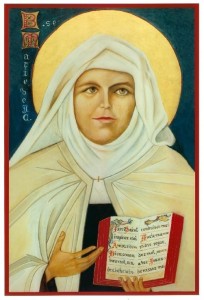 Earlier today in Rome, the Holy Father canonized some new saints. Among the 4 new saints is Saint Mariam Baouardy (5 January 1846 – 26 August 1878), a Discalced Carmelite nun of the Melkite Catholic Church. She was born to Greek Catholic parents in Ibillin, Galilee. Saint Mariam had the distinguished reputation of being a mystic and a person gifted with the experience of the holy stigmata (the physical wounds in the hands and feet that Jesus suffered and which redeemed us).
Earlier today in Rome, the Holy Father canonized some new saints. Among the 4 new saints is Saint Mariam Baouardy (5 January 1846 – 26 August 1878), a Discalced Carmelite nun of the Melkite Catholic Church. She was born to Greek Catholic parents in Ibillin, Galilee. Saint Mariam had the distinguished reputation of being a mystic and a person gifted with the experience of the holy stigmata (the physical wounds in the hands and feet that Jesus suffered and which redeemed us).